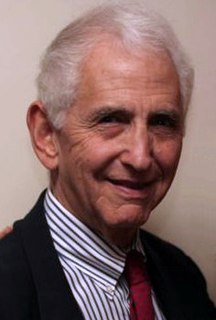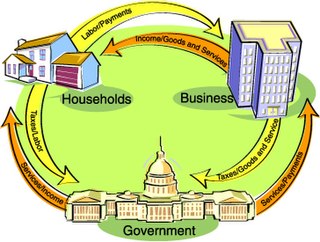Related Research Articles
Controversy is a state of prolonged public dispute or debate, usually concerning a matter of conflicting opinion or point of view. The word was coined from the Latin controversia, as a composite of controversus – "turned in an opposite direction".

Economics is the social science that studies how people interact with value; in particular, the production, distribution, and consumption of goods and services.

In economic science, the tragedy of the commons is a situation in which individual users, who have open access to a resource unhampered by shared social structures or formal rules that govern access and use, act independently according to their own self-interest and, contrary to the common good of all users, cause depletion of the resource through their uncoordinated action. The concept originated in an essay written in 1833 by the British economist William Forster Lloyd, who used a hypothetical example of the effects of unregulated grazing on common land in Great Britain and Ireland. The concept became widely known as the "tragedy of the commons" over a century later after an article written by Garrett Hardin in 1968.
Environmental economics is a sub-field of economics concerned with environmental issues. It has become a widely studied subject due to growing environmental concerns in the twenty-first century. Environmental economics "undertakes theoretical or empirical studies of the economic effects of national or local environmental policies around the world.... Particular issues include the costs and benefits of alternative environmental policies to deal with air pollution, water quality, toxic substances, solid waste, and global warming."

In economics, an externality is a cost or benefit for a third party who did not agree to it. Air pollution from motor vehicles is one example. The cost of air pollution to society is not paid by either the producers or users of motorized transport. The concept of externality was first developed by economist Arthur Pigou in the 1920s.
Regulation is the management of complex systems according to a set of rules and trends. In systems theory, these types of rules exist in various fields of biology and society, but the term has slightly different meanings according to context. For example:
The game of chicken, also known as the hawk–dove game or snowdrift game, is a model of conflict for two players in game theory. The principle of the game is that while the ideal outcome is for one player to yield, the individuals try to avoid it out of pride for not wanting to look like a 'chicken'. So each player taunts the other to increase the risk of shame in yielding. However, when one player yields, the conflict is avoided, and the game is for the most part over.
Conflict resolution is conceptualized as the methods and processes involved in facilitating the peaceful ending of conflict and retribution. Committed group members attempt to resolve group conflicts by actively communicating information about their conflicting motives or ideologies to the rest of group and by engaging in collective negotiation. Dimensions of resolution typically parallel the dimensions of conflict in the way the conflict is processed. Cognitive resolution is the way disputants understand and view the conflict, with beliefs, perspectives, understandings and attitudes. Emotional resolution is in the way disputants feel about a conflict, the emotional energy. Behavioral resolution is reflective of how the disputants act, their behavior. Ultimately a wide range of methods and procedures for addressing conflict exist, including negotiation, mediation, mediation-arbitration, diplomacy, and creative peacebuilding.
Economists use the term representative agent to refer to the typical decision-maker of a certain type.
Evolutionary game theory (EGT) is the application of game theory to evolving populations in biology. It defines a framework of contests, strategies, and analytics into which Darwinian competition can be modelled. It originated in 1973 with John Maynard Smith and George R. Price's formalisation of contests, analysed as strategies, and the mathematical criteria that can be used to predict the results of competing strategies.
A coordination game is a type of simultaneous game found in game theory. It describes the situation where a player will earn a higher payoff when he selects the same course of action as another player. The game is not one of pure conflict, which results in multiple pure strategy Nash equilibria in which players choose matching strategies. Figure 1 shows a 2-player example.

In macroeconomics, the guns versus butter model is an example of a simple production–possibility frontier. It demonstrates the relationship between a nation's investment in defense and civilian goods. The "guns or butter" model is used generally as a simplification of national spending as a part of GDP. This may be seen as an analogy for choices between defense and civilian spending in more complex economies. The nation will have to decide which balance of guns versus butter best fulfills its needs, with its choice being partly influenced by the military spending and military stance of potential opponents.
In contract theory, signalling is the idea that one party credibly conveys some information about itself to another party. Although signalling theory was initially developed by Michael Spence based on observed knowledge gaps between organisations and prospective employees, its intuitive nature led it to be adapted to many other domains, such as Human Resource Management, business, and financial markets.

The Ellsberg paradox is a paradox of choice in which people's decisions produce inconsistencies with subjective expected utility theory. The paradox was popularized by Daniel Ellsberg in his 1961 paper “Risk, Ambiguity, and the Savage Axioms”, although a version of it was noted considerably earlier by John Maynard Keynes. It is generally taken to be evidence for ambiguity aversion, in which a person tends to prefer choices with quantifiable risks over those with unknown risks.
A collective action problem or social dilemma is a situation in which all individuals would be better off cooperating but fail to do so because of conflicting interests between individuals that discourage joint action. The collective action problem has been addressed in political philosophy for centuries, but was most clearly established in 1965 in Mancur Olson's The Logic of Collective Action.

Microfoundations are the microeconomic behaviours of individual agents, like households or businesses, on which an economic theory is based. Research in microfoundations explores the link between macroeconomic and microeconomic principles in order to explore the aggregate relationships in macroeconomic models.
Integrated assessment modelling (IAM) or integrated modelling (IM) is a term used for a type of scientific modelling that tries to link main features of society and economy with the biosphere and atmosphere into one modelling framework. The goal of integrated assessment modelling is to accommodate informed policy-making, usually in the context of climate change though also in other areas of human and social development. While the detail and extent of integrated disciplines varies strongly per model, all climatic integrated assessment modelling includes economic processes as well as processes producing greenhouse gases. Other integrated assessment models also integrate other aspects of human development such as education, health, infrastructure, and governance.
Social preferences describe the human tendency to not only care about his/her own material payoff, but also the reference group's payoff or/and the intention that leads to the payoff. Social preferences are studied extensively in behavioral and experimental economics and social psychology. Types of social preferences include altruism, fairness, reciprocity, and inequity aversion. The field of economics originally assumed that humans were rational economic actors, and as it became apparent that this was not the case, the field began to change. The research of social preferences in economics started with lab experiments in 1980, where experimental economists found subjects' behavior deviated systematically from self-interest behavior in economic games such as ultimatum game and dictator game. These experimental findings then inspired various new economic models to characterize agent's altruism, fairness and reciprocity concern between 1990 and 2010. More recently, there are growing amounts of field experiments that study the shaping of social preference and its applications throughout society.

The winner and loser effect is an aggression phenomenon in which the winner effect is the increased probability that an animal will win future aggressive interactions after experiencing previous wins, while the loser effect is the increased probability that an animal will lose future aggressive interactions after experiencing previous losses. Overall these effects can either increase or decrease an animals aggressive behaviour, depending on what effect affects the species of concern. Animals such as Agkistrodon contortrix, Rivulus marmoratus, and Sula nebouxii show either both or one of these effects.
References
- ↑ Besley, Timothy; Ghatak, Maitreesh (2009). "Property Rights and Economic Development" (PDF). In Rodrick, Dani; Rosenzweig, Mark R. (eds.). Handbook of Development Economics, Volume 5. Amsterdam: North Holland. pp. 4252–4595. ISBN 978-0-444-52944-2.
- ↑ Hirshleifer, Jack (1 November 1991). "The Paradox of Power" (PDF). Economics and Politics. 3 (3): 177–200. doi:10.1111/j.1468-0343.1991.tb00046.x.
- 1 2 Garfinkel, Michelle R.; Skaperdas, Stergios (1 January 2006). "Economics of conflict: an overview". doi:10.2139/ssrn.895307. SSRN 895307 .Cite journal requires
|journal=(help) - ↑ Noh, Suk Jae (March 2002). "Resource distribution and stable alliances with endogenous sharing rules". European Journal of Political Economy . 18 (1): 129–151. doi:10.1016/S0176-2680(01)00072-6.
- ↑ Skaperdas, Stergios (July 1998). "On the formation of alliances in conflict and contests". Public Choice . 96 (1–2): 25–42. doi:10.1023/A:1004912124496. JSTOR 30024376.
- ↑ Olson, Mancur (1971) [1965]. The logic of collective action: public goods and the theory of groups (revised ed.). Cambridge, Massachusetts: Harvard University Press. ISBN 978-0-674-53751-4.
- ↑ Yi, Sang-Seung (1 January 1996). "Stable coalition structures with externalities". doi:10.2139/ssrn.2071. SSRN 2071 .Cite journal requires
|journal=(help)